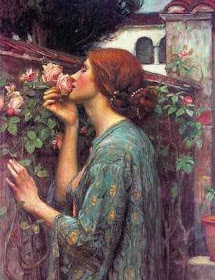
Art influenced by the art and themes of the Pre Raphaelites with biographies, auctions and information on these artists.
Pages
▼
Saturday, October 31, 2009
Friday, October 30, 2009
Thomas Charles Farrer

[Mount Tom]
1865
oil on canvas
16 x 24.5"
.
http://goldenagepaintings.blogspot.com/2009/07/thomas-charles-farrer.html
1839-1891.
Farrer was trained at the Working Men's College in Red Lion Square where Madox Brown, Ruskin and Rossetti all taught. Farrer pioneered Ruskin's techniques in the States as an art instructor at the Cooper Union in NY City from 1861-5. He applied the PR techniques to the American landscape as in this view.
Thursday, October 29, 2009
Wednesday, October 28, 2009
Tuesday, October 27, 2009
Monday, October 26, 2009
Ford Madox Brown - Study - The Seeds and Fruits of English Poetry

1853
Oil on canvas
13.5 x 18 1/4"
Ashmolean
FORD MADOX BROWN DEST IN ROMA. 1845. COLORAVIT IN HAMPSTEAD. 1853
Seeds and Fruits was planned in London and composed in Rome in 1845. 'During my sojourn'. Brown recalled, 'Italian art had made a deep and, as it proved, lasting impression on me, for I never afterwards returned to the sombre, Rembrandtesque style I had formerly worked in'. The influence of the Italian artists before Raphael is obvious in the triptych-like format, in the gothic arches, in the six poets arranged like saints on a gold ground in the wings of a medieval altar piece and in the bright colour. However, in 1851, when Brown finished the large picture, for which this is a study, he omitted all the gothic detail and, later, justified the bright colour as a novel attempt to introduce effects of bright sunlight into painting. Brown, by the early 50s had succumbed to the Pre-Raphaelite ideal of 'truth to nature' but not before he had given his disciple, Rossetti, a lasting taste for the art of the 'Early Christians'.
The centre panel shows Chaucer reading at the court of Edward III with his patron, the Black Prince, on his left. In the wings appear the 'fruits' of English poetry: Milton, Spenser and Shakespeare on the left; Byron, Pope and Burns on the right: Goldsmith and Thomson in the roundels; and the names of Campbell, Moore, Shelley Keats, Chatterton, Kirke White, Coleridge and Wordsworth are written on the cartouches held by the standing children in the base.
Sunday, October 25, 2009
Ford Madox Brown (designer) - Architecture window
Saturday, October 24, 2009
Friday, October 23, 2009
Edward Burne-Jones - Portrait of Georgiana Burne-Jones
Thursday, October 22, 2009
Wednesday, October 21, 2009
Tuesday, October 20, 2009
Monday, October 19, 2009
Sunday, October 18, 2009
John Everett Millais - Chill October

1879
Oil on canvas
Private collection
Oil on canvas
Private collection
Kathleen Jamie on Millais' 'Chill October'
Chill October c. 1870
© Collection of Lord Lloyd-Webber
Oil on canvas
175.5x221.3x10cm
http://www.tate.org.uk/tateetc/issue11/poeticencounters.htm
Saturday, October 17, 2009
John Everett Millais

[For the Squire]
The Millais model
Brian Sewell, Evening Standard
Millais, Ruskin, and the love triangle which tore apart the pre-Raphaelites
Jonathan Brown, Independent
John Millais's Children: Faith, Erotics, and the Woodman's Daughter
Journal article by Robert M. Polhemus; Victorian Studies, Vol. 37, 1994
Journal article by Robert M. Polhemus; Victorian Studies, Vol. 37, 1994
Rossetti's Wombat

Rossetti's Wombat: Pre-Raphaelites and Australian Animals in Victorian London
by John Simons
Middlesex University Press (2008)
http://www.amazon.co.uk/Rossettis-Wombat-Pre-Raphaelites-Australian-Victorian/dp/1904750605/ref=sr_1_1?ie=UTF8&s=books&qid=1244568757&sr=1-1
.
I learnt a lot from this book and found it a really good read.











































